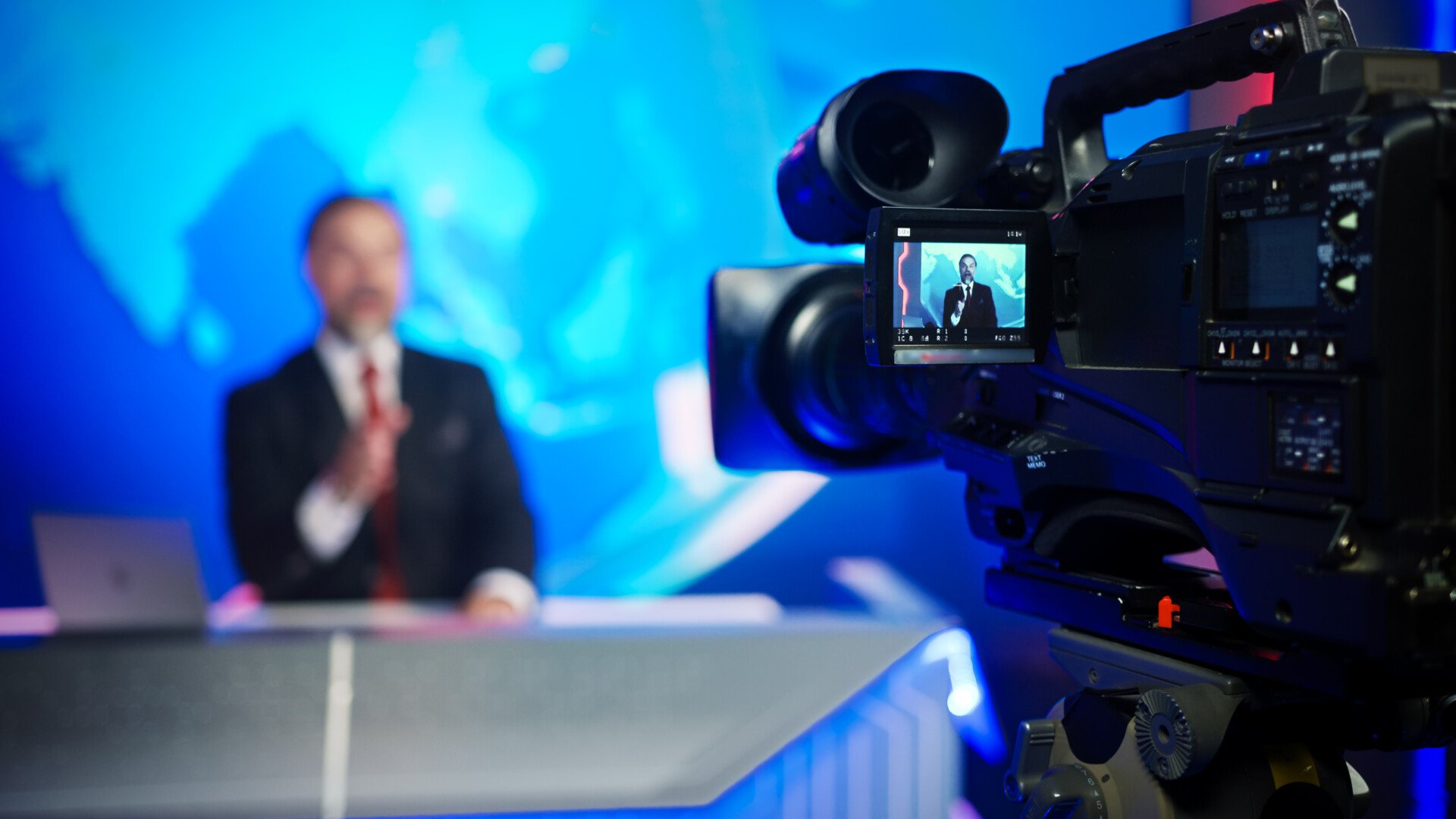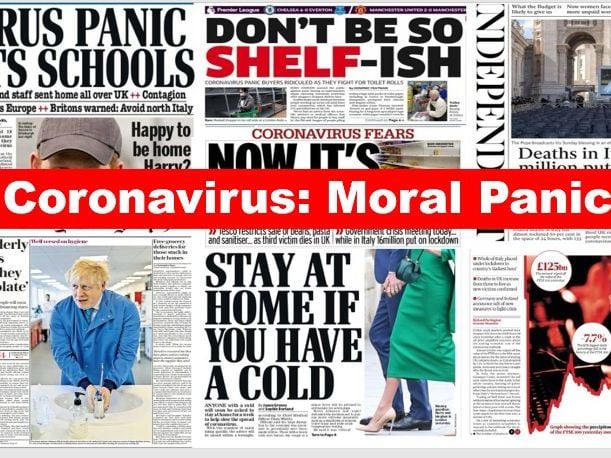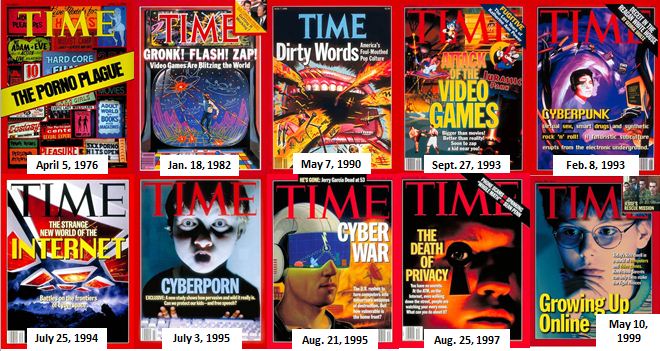On This Page:
A moral panic refers to an intense feeling of fear, concern, or anger throughout a community in response to the perception that cultural values or interests are being threatened by a specific group, known as folk devils. Moral panics are characterized by an exaggeration of the actual threat posed by the perceived folk devil.
Moral panic is a widespread fear and often an irrational threat to society’s values, interests, and safety.
Typically, a moral panic is perpetuated by the news media, most times engaged by politicians, and can result in increased social control.
Key Takeaways
- Moral panic is a situation in which media reporting has created a folk devil of a particular social group, and the public demands the authorities that something be done about it.
- This expression of concern is described as a moral panic because it is based on an outraged sense of offense to public standards of behavior. However, the information which prompts it is often limited and inaccurate.
- Folk devils refer to a group whose common interest or activity has become stigmatized by society and becomes the target for adverse comments and behavior.
The criminological and sociological concept known as moral panic offers valuable insight into why and how powerful social agents like the media create public concern.

Stanley Cohen’s Theory
Stanley Cohen is a late South African criminologist who was influenced by Becker and the labeling theory.
He developed and popularized the term and stated that moral panic occurs when “a condition, episode, person or group of persons emerges to become defined as a threat to societal values and interests.” (Cohen, 1972, p. 1).
He clarified that while the issues addressed and identified were real, the claims made exaggerated the harm’s seriousness or inevitability.
Cohen used an example to explain by mentioning the story of two youth subcultures: the “mods” and the “rockers” who initially existed peacefully side by side.
Both groups were the first two youth subcultures in consumer society and were mainly concerned with style, music, and having fun.
To summarize what happened, one holiday weekend, both the mods and rockers had a party where minor acts of vandalism occurred between the groups.
This led to the news media arriving at the next party involving the mods and rockers, ready to report any disturbances. Once again, minor vandalism happened, and the media published highly exaggerated reports of the extent of violence between the two groups.
This generated public concern and the police responded by policing future parties involving the mods and rockers, resulting in more arrests for non-violent deviant behavior.
Hence, the mods and rockers came to see themselves as enemies, and all of this was fueled by exaggeration published by the media.
Cohen’s work illustrated how these kinds of reactions influence the formation and enforcement of the law, social policy, and societal perceptions of threats, especially those posed by youth groups.
Since its development, the moral panic concept has been applied to many social problems, including youth gangs and school violence.
Characteristics of Moral Panic
Central to the moral panic concept, there is an argument that public fear or concern over a social problem is mutually beneficial to state officials, law enforcement authorities, politicians, and the news media.
There is an apparent symbiotic relationship between the news media and state officials in that law enforcement and politicians need communication channels to distribute their stories and rhetoric, and the media is constantly looking for compelling news content to attract a big audience, also attracting advertisers.
Therefore, moral panics arise when exaggerated and distorted mass media campaigns are used to create fear, reinforce stereotypes, and add tension to preexisting divisions based on race/ethnicity and social class.
Let’s go over the three distinguishing characteristics moral panics have:
- There is focused attention on the behavior (real or imagined) of certain groups or individuals transformed into what Cohen refers to as “folk devils” by the mass media. We see this when the media strips these “folk devils” of all favorable characteristics and exclusively applies negative ones to create an evil persona we simply cannot get behind.
- There is a gap between the concern over a situation and the objective threat it poses. Usually, the objective threat is far less than popularly perceived due to how authorities present it.
- There is a great deal of fluctuation over time in the level of concern of a condition or situation. The typical pattern starts with discovering the threat, followed by a fast rise, then the peak of public crisis, which then subsequently and abruptly subsides. Public hysteria often results in the passing of legislation that is very vindictive, unnecessary, and serves to justify the agendas of those in power and authority.
Social Actors of Moral Panic
Moral panics don’t just occur spontaneously. Instead, they result from complex dynamics and interplay among several social actors. As initially explained by Cohen, there are five social actors involved in moral panic. Let’s go over them.
Folk Devils
As we previously touched upon, in the lexicon of moral panic scholars, folk devils are individuals who are socially alleged or defined to be responsible for bringing a threat to society.
Unlike other malicious characters, folk devils are entirely evil and are stripped from anything positive or anything that could possibly contribute to their likeability. They are simply the embodiment of a “bad guy” and are deemed the antagonists in a moral panic drama.
Rule or Law Enforcers
The police, prosecutors, or the military are crucial to a moral panic as they are deemed to enforce and uphold the codes of conduct and the official laws of the country or state.
These agents of the government are expected to detect, apprehend, and punish the so-called folk devils. Law enforcers have a strong obligation as they have sworn duty and moral responsibility to protect society from folk devils when they are present.
Furthermore, law enforcers must work to maintain and justify their positions in society – a moral panic can offer law enforcers respect and purpose by ridding folk devils that allegedly threaten the well-being of society.
The Media
As we know, the media is compelling in the creation and continuity of a moral panic. Usually, news media coverage of particular events involving labeled folk devils is greatly exaggerated or distorted.
The coverage brought by the news emphasizes folk devils and makes them appear much more of a threat to society than they genuinely are. Therefore, journalistic hyperbole regarding folk devils is heightened public concern and anxiety, leading to moral panic.
Moreover, two critical media practices contribute to moral panic, which include priming and framing. Priming is when exposure to one stimulus impacts how a person responds to a subsequent, relevant stimulus. Framing refers to how an issue is given to the public or the specific angle in which the media presents it.
It involves calling attention to certain aspects of a problem while ignoring or obscuring other elements. In other words, framing gives perspective meaning to an issue.
Based on research, the news media relies on frames to determine what events to cover and how to portray them. Just as photographers line up a shot, the journalist’s line of news frame affects the story. Additionally, the choice of frame is influenced by prior news frames, history, ideology, power, and authority of news sources.
Therefore, news frames are even negotiated phenomena rather than being based solely on objective situations. More importantly, an audience will react very differently to an issue or story depending on how it is framed by the news – as we all know.
Priming, on the other hand, is a psychological process where the news emphasizes a specific issue to increase the salience of the matter publicly and activate previously acquired information about the case from people’s memories.
The priming technique explains how the news frame is used in a certain story to trigger an individual’s subconscious and preexisting attitudes, prejudices, and beliefs regarding the presented issue.
Politicians
Again, politicians are vital actors in the moral panic drama. As elected officials operate in the stage of public opinion, they must present themselves as the protectors or heroes of the moral high ground in society.
Hand in hand with law enforcers, politicians have a sworn duty and moral obligation to protect the community from alleged folk devils if and when they arise.
Politicians often arouse moral panic by joining the media and law enforcers in an ethical campaign against the evil bad guys – the folk devils.
An example would be President Ronald Reagan in the late 1980s, where he defined the folk devils as cocaine dealers and precipitated a moral panic over the evils of crack cocaine and the alleged threats of the present sins.
The Public
There is no doubt that the public is the most crucial factor in the creation of moral panic. Public agitation, concern, and anxiety over the identified folk devils is the key element of moral panic.
The happening of moral panic only exists to the extent of a public outcry over the dooming, alleged threat posed by the folk devils.
Moreover, the success of politicians, the media, and law enforcers in accelerating and maintaining a moral panic is ultimately contingent upon how successfully they arouse and fuel concern, outrage, and anxiety toward the folk devils among the public.
Examples of Moral Panics
During 2020 we all experienced a situation where public fears greatly exceeded the threat that was posed to society – the COVID-19 pandemic.
Since the virus, illness, and spread happened so suddenly, the information from the experts was not disseminated fast enough to reach the community at the right time.
And because of this lack of knowledge and abundance of misinformation, there were exaggerated media headlines that fueled the health-related fears and phobias circulating around, still today.
This public fear, and those responsible for creating and promoting it, is an important topic of discussion, especially amidst the pandemic.

Another aspect of moral panic can be centered around marginalized people in society due to race or ethnicity, sexuality, nationality, class, or religion (e.g., the LGBT+ community.)
Therefore, moral panic can draw on known stereotypes and reinforce them while exacerbating the actual and perceived divisions and differences between communities and people.
Moral panic is recognized in the sociology of deviance and crime as well as being related to the labeling theory of deviance.
Technology Moral Panics
- Moral Panic over Social Media
- Moral Panic over Cyber Crime
- Moral Panic over Computer Game Violence

Summary
To summarize the moral panic, let’s skim through the stages again:
- Something or someone is identified and defined as a threat to society and/or social norms as well as the interests of the community or society at large. The so-called “folk devils.”
- The media and community members depict the threat in simplistic yet symbolic ways that are promptly recognizable to the greater public.
- Extensive public concern is excited by the way the news media portrays the symbolic depiction of the threat.
- With new laws or policies, the authorities and policymakers respond to the threat, be it real or perceived.
- In the final stage, moral panic and the following actions of those in power lead to a cultural or official change in society.
References
Cannon, W. B. (1915). Bodily changes in pain, hunger, fear, and rage. New York: Appleton-Century-Crofts.
Kirby, Stephanie. “Fight Flight Freeze: How to Recognize It and What to Do …” Edited by Aaron Horn, Betterhelp, https://www.betterhelp.com/advice/trauma/fight-flight-freeze-how-to-recognize-it-and-what-to-do-when-it-happens/.
Schauer, M., & Elbert, T. (2010). Dissociation following traumatic stress. Journal of Psychology, 218, 109-127.
What Happens During Fight or Flight Response. (2019, December 09). Retrieved from https://health.clevelandclinic.org/what-happens-to-your-body-during-the-fight-or-flight-response/


